Lilac stands out among all spring flowers with its lush and fragrant blooms. It is difficult to imagine a personal or garden plot without this ornamental shrub. The culture is unpretentious, does not require special care, and therefore thrives in different climatic and soil conditions.The main thing is to follow the rules for planting lilacs in open ground and choose the right place for it.
| Content:
|
Where and when is the best time to plant lilacs?
Choosing a place for seedlings
Choosing a place to plant lilacs is not difficult if you take into account all the favorable conditions:
- exposure to the sun most of the day;
- location of groundwater at a depth of more than 1.5 m from the surface;
- fertile soil;
- neutral soil acidity;
- protection from cold winds.
Compliance with these conditions allows lilacs to actively develop and bloom.
|
A sunny location is very important for the culture. In shade, the shrub grows slowly, the shoots become longer, the foliage becomes thinner, and the flowering is less abundant. |
If the site is located in a lowland and is periodically flooded with melt and rainwater, then lilacs are planted on an earthen hill. The dimensions of the hill must take into account all the imperfections of the terrain in order to protect the roots from moisture and frost.
For good development, the plant needs fertile and light soil. Lilac will take root in poor soil, but will grow slowly.
Sandy, poor soils are enriched with alumina or chernozem. Heavy soils are diluted with sand, peat or leaf humus. In heavy soil, roots suffer from oxygen deficiency and, as a result, rot and die.
Acidic soils are neutralized periodically with slaked lime, dolomite flour and ash.
Protection of lilacs from cold winds is especially necessary for less winter-hardy varieties.
When is it better to plant lilacs in spring or autumn?
Gardeners are divided on the timing of planting lilac seedlings.In fact, this procedure can be carried out from spring to autumn, but following some rules:
- spring planting of seedlings must be completed before the active growing season begins and the buds awaken;
- Summer planting of lilacs is best done in mid-summer. At this time, the bushes begin to prepare for the winter season and will tolerate replanting well.
- Autumn planting of lilac seedlings should be carried out from mid-August to mid-September. At this time, the weather is still warm, frost is far away, so the seedlings have time to take root successfully.
Important! Planting time also depends on the planting material. Experts advise planting seedlings with an open root system immediately after purchase.
Planting lilacs in spring
In the climate of the Central Russian region, it is difficult to plant and care for seedlings in the spring, since the growing season for lilacs begins early, when there is still snow on the plots and in parks.
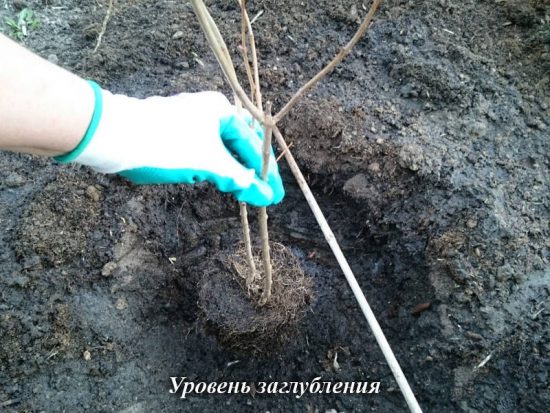 The main thing is to have time to plant lilacs before the sap begins to flow and the buds awaken. The main thing is to have time to plant lilacs before the sap begins to flow and the buds awaken. |
The second problem is slow rooting, since the main forces of the plant will be spent on the formation of foliage and flowering. The bush will be weak in the year of planting and will lag behind in development. For better survival of seedlings in the spring, you need to take the following actions:
- treat the roots of the plant with a biostimulant;
- cut off all flower buds;
- Regularly moisten and loosen the soil around the bush.
Planting lilacs in the fall
Autumn, namely the end of the summer season, is the optimal time for planting all varieties of lilacs.
The crop begins to prepare for wintering, shoot growth stops, and sap flow slows down. But there is still time before winter, the earth is still warm, so the planting material will have time to take root and prepare for the cold.
This is facilitated by abundant watering immediately after planting and 1-2 waterings before the onset of frost if the weather remains dry.
If the seedling was purchased in October and there are about 2 weeks left before frost, measures must be taken to cover the plantings to protect the roots of the plant. To do this, cover the soil around the bushes with a thick layer of mulch.
|
Lilacs should be planted in autumn from mid-August to the end of September. Then the seedlings will have time to take root and overwinter well. |
Dry crushed tree bark, straw, peat, leaf litter, pine needles, and tree shavings can be used as shelter. Mulch 20 cm thick will stop soil freezing, which will give lilac seedlings time to take root. As a result, the bushes will survive the winter successfully and will begin to fully develop in the spring.
If seedlings are purchased at a later date, planting and care should be postponed until spring. In this case, the bushes are buried at an angle to the soil in a place protected from the cold.
At the same time, planting holes are prepared in advance for spring planting, since this will be difficult to do in the spring due to the early planting dates.
Planting plants with a closed root system
Seedlings with a closed root system have a great advantage compared to seedlings with an open root system. Such plants are ready for planting at any time during the growing season and are easier to care for.
|
Bushes with a closed root system can be planted in the ground throughout the summer season. |
When purchasing seedlings with a closed root system, you should pay attention to their size. The optimal container volume is considered to be from 2 to 12 liters. Lilacs in small containers (0.5-1.5 l) require growing in a seedling bed for 2-3 years before planting in open ground.
Seedlings are planted in a permanent place after they reach a height of 1 m.
Video about the timing and rules of planting lilacs:
Landing rules
The optimal time for planting lilacs in open ground is a cloudy day or evening hours. Lilacs are planted as follows:
- Remove damaged branches.
- Dig a planting hole measuring 50x50 cm.
- Compost or humus (10-15 kg), superphosphate (25-35 g) and ash (250 g) are added to the soil from the pit. If the soil on the site is acidic, the amount of ash is doubled.
- A layer of drainage is poured onto the bottom of the planting hole, then the hole is filled with nutrient soil in the form of a mound.
- A seedling is placed on a mound, straightening the roots.
- Fill the hole with prepared soil, lightly shaking the bush to fill the voids, and compact it.
- Water - 5 liters of water per bush. After planting, the tree trunk circle should be mulched, which will retain moisture and prevent weeds from growing.
Important! The position of the root collar can be different and depends on the type of planting material.
When planting a bush grafted onto common lilac, the root collar is placed 2-3 cm above ground level, and the grafting site is even higher. This reduces the appearance of rootstock growth.
Self-rooted plants are planted with the root collar buried slightly below the surface of the earth. This technique stimulates the development of new roots and the formation of shoots.
Lilac care
Only by following all the rules for planting and caring for lilacs can you enjoy the contemplation of beautiful bushes as in the photo and the aroma of numerous flowers.
|
Standard lilac in the garden |
Watering
When caring for lilacs in the summer, it is necessary to water the tree trunk as it dries. Liquid consumption per bush is up to 30 liters. Weeding and loosening throughout the season will help retain moisture in the soil.In August and September, lilacs are watered only in case of drought.
Feeding
Feeding depends on the age of the plant. During the first 2-3 years, young bushes are fed only with nitrogen fertilizers in small doses. From the second year, urea (40-65 g) or ammonium nitrate (60-75 g) is added to the soil around each bush.
|
A simple and affordable universal fertilizer, which gardeners often use when caring for crops, is an infusion of ash (200 g) in water (8 l). |
Subsequently, every 2-3 years, fertilizing is necessary in the form of phosphorus and potassium fertilizers (30 g of potassium nitrate and 35 g of double superphosphate).
When caring for lilac seedlings, one should not neglect the use of organic fertilizers, such as slurry. The solution is prepared by diluting 1 part cow dung in 5 parts water. To apply fertilizer, dig a shallow furrow along the perimeter of the tree trunk circle, at a distance of 0.5 m from the trunks.
Trimming
Competent gardeners prune lilacs in early spring, before the growing season begins. This is an important element of crop care. Lilac bushes under two years old are not pruned at all, since they have not yet formed all the main branches.
|
This pruning will give the bush fullness and decorativeness. |
Form a crown start at 3-year-old bushes. To form skeletal branches, leave 5-7 strong branches. The remaining shoots and root shoots are removed. Next spring you need to cut off half of the flowering branches. The remaining shoots are also shortened, leaving no more than 7 buds on them.
Lilac can also be shaped into a small tree.
Important! Simultaneously with decorative pruning, sanitary pruning is carried out, removing all dry or damaged branches, as well as shoots with signs of disease.
In order for a bouquet of lilacs to last for a long time, they should be cut early in the morning and the lower cut of the branch should be split. After flowering, all wilted brushes are removed.
Lilac propagation
Having at least one lilac bush, a gardener can easily obtain a sufficient amount of planting material. There are many ways to propagate lilacs:
- seeds;
- cuttings;
- root shoots.
Each method has its own characteristics, advantages and disadvantages.
Propagation by cuttings
Propagation of lilacs by green cuttings in the spring is quite possible at home.
Cuttings are cut directly during flowering or immediately after it ends. They do this in the morning, harvesting green shoots 4-5 mm thick. The length of the cuttings is 15 cm with 2-3 nodes.
|
The lower leaves are removed from the cut branches, and the upper leaves are shortened by half, as shown in the photo. |
The lower cut is made obliquely, 1 cm away from the bud, and the upper cut is made at a right angle. The step-by-step scheme for cuttings at home is as follows:
- The cuttings are placed with an oblique cut in a biostimulator for 12 hours.
- A 25 cm layer of soil is poured into the seedling container, and 6 cm of coarse sand is poured on top. Lilac cuttings are planted in a layer of sand to a depth of 1 cm so that the leaves of neighboring seedlings do not touch each other.
- After moistening the plantings, the seedling container is covered with film, or an inverted transparent plastic bottle with a cut off neck is placed over each cutting.
- Cuttings take root better in partial shade. The soil should always be moist. Once a week, plantings are sprayed with a pale solution of potassium permanganate to avoid infection with fungi.
- The roots of the cuttings will appear in 1.5-2 months, and after that they begin to ventilate the cuttings every day, and over time the greenhouses are removed.
If the roots formed in the summer, the seedlings are planted in open ground and covered with spruce branches for the winter. But if the roots have formed closer to autumn, lilac seedlings are left to overwinter in containers and transplanted into unprotected soil only in the spring.
|
With proper care, lilacs from green cuttings begin to bloom in the 5th year. |
Cutting lilacs with lignified shoots does not give results; this is rather an exception to the rule.
Reproduction by root shoots
|
Propagation of lilacs by root shoots is considered the simplest and most productive method of obtaining high-quality planting material. |
To separate the root shoots, choose a strong, already flowering bush. They do this in the canopy, on a cloudy day; the root system is not so sensitive during this period. The selected bush is pre-watered. The young seedling is carefully separated, trying not to damage the roots, and transplanted to a permanent place.
The new plant will bloom in 3 years.
Seed propagation
- Lilac seeds are collected in the fall in wet weather so that the seeds do not accidentally spill. After that, the boxes with seeds are dried at room temperature, and the seeds are shaken out of them.
- The seeds are stratified: sprinkled with wet sand and kept for 2 months at a temperature of 0°... +5°C. It is necessary to maintain sand moisture.
- Lilac seeds are planted in mid-March indoors in garden soil to a depth of 10-20 mm. The crops are moistened. Depending on the variety, seedlings will appear in 10 days or 2-3 months.
- After the formation of 2 pairs of leaves, the seedlings are planted in seedling containers in increments of 5 cm, and when warm weather sets in, the seedlings are moved to open ground.
|
Lilac seeds |
You can sow seeds before winter in slightly frozen ground - this will eliminate the stratification procedure.The seeds are buried 1.5 cm into the soil, mulched, and in the spring they are planted in containers and grown.
Propagation by seeds is a labor-intensive process, so at home it is better to use cuttings, propagation by root shoots or dividing the bush.
Lilac in landscape design
Lilac is actively used in decorating gardens, personal plots, and in the landscape design of city parks and recreation areas, as in the photo. Designers and gardeners love lilacs for their beauty, unpretentiousness, and good tolerance to formative pruning.
The location and number of bushes of the crop depends on the type of lilac, its variety and design concept. These can be saltpeter (single) plantings, small groups of plants or hedge.
|
Lilac hedge. |
When planting a green hedge plants will need increased feeding and careful care. A hedge made from different varieties of crops looks original. If you alternate inflorescences of white, lilac, pink and purple flowers, then such a flowering hedge will not go unnoticed.
 Standard lilac in the park Standard lilac in the park |
Tall varieties of lilac are most often planted individually near the house or in the center of the lawn. Small species grow well in groups of 3-5 pieces or in alleys.
Important! The distance between lilac bushes for single planting is optimally at least 2-2.5 m, for group planting and in alleys - at least 1.5 m. The planting density in a green hedge is 1 m.
Monochrome plant compositions consisting of lilac bushes and any other beautifully flowering crops with flowers of the same color look beautiful.
|
For example, the proximity of lilacs and white peonies, which bloom at the same time, complement each other favorably. |
Amateur gardeners use miniature types of lilacs in the design of alpine slides.
|
Lilac planted in combination with other ornamental shrubs |
Since lilac blooms for only a few weeks, it is planted in the garden next to shrubs that bloom at other times. The list of neighbors for lilacs is quite large:
- hydrangea of various varieties;
- spirea;
- mock orange;
- almond;
- coniferous shrubs.
There are cultures that lilacs do not like to be in proximity to. These are all fruit bushes and trees, as they take a lot of nutrients from the soil.

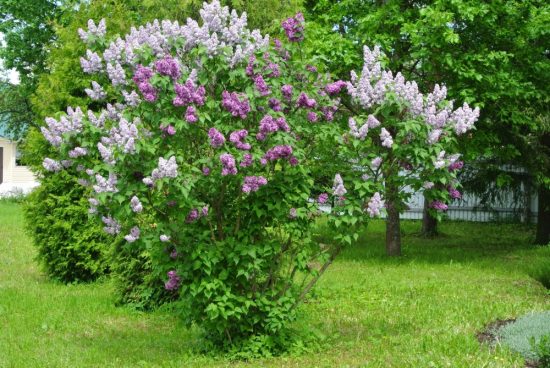
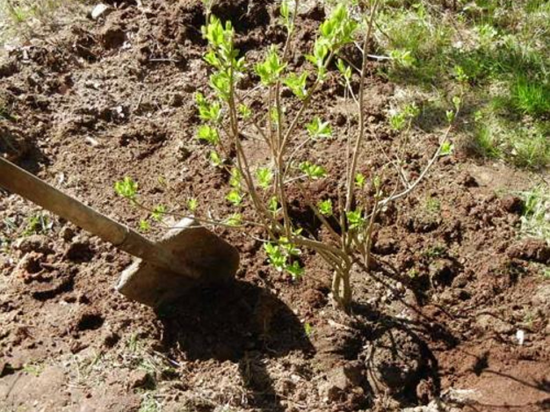



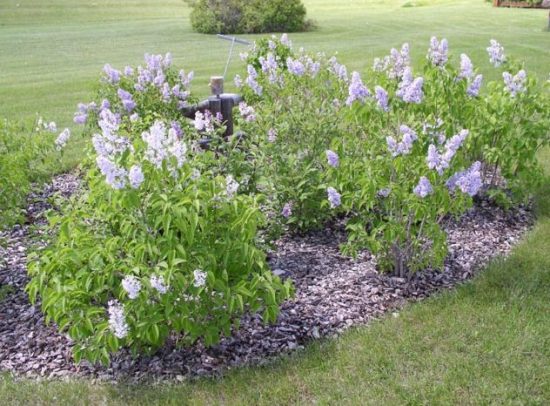
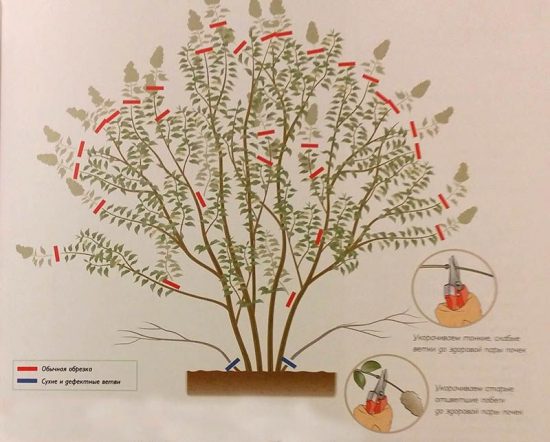
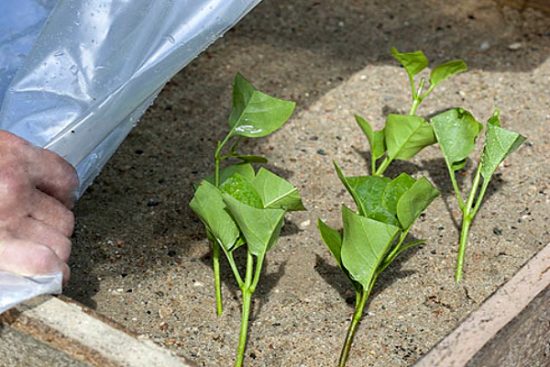


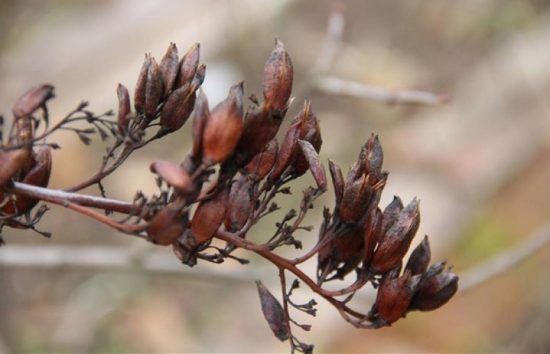
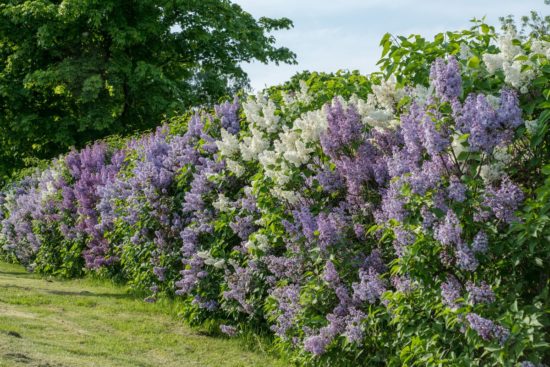
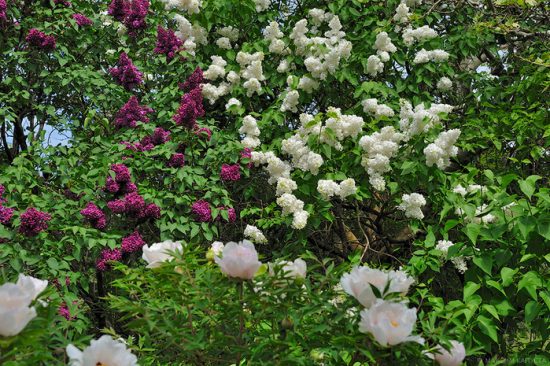
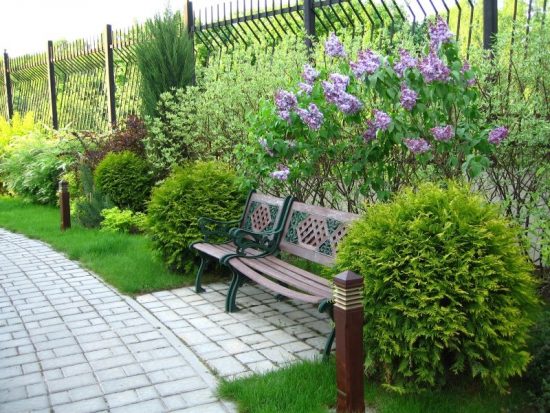

 (8 ratings, average: 4,38 out of 5)
(8 ratings, average: 4,38 out of 5) CUCUMBERS NEVER GET SICK, I'VE BEEN USING ONLY THIS FOR 40 YEARS! I SHARE A SECRET WITH YOU, CUCUMBERS ARE LIKE THE PICTURE!
CUCUMBERS NEVER GET SICK, I'VE BEEN USING ONLY THIS FOR 40 YEARS! I SHARE A SECRET WITH YOU, CUCUMBERS ARE LIKE THE PICTURE! You can dig a bucket of potatoes from each bush. Do you think these are fairy tales? Watch the video
You can dig a bucket of potatoes from each bush. Do you think these are fairy tales? Watch the video
 How our fellow gardeners work in Korea. There is a lot to learn and just fun to watch.
How our fellow gardeners work in Korea. There is a lot to learn and just fun to watch. Eye trainer.The author claims that with daily viewing, vision is restored. They don't charge money for views.
Eye trainer.The author claims that with daily viewing, vision is restored. They don't charge money for views. A 3-ingredient cake recipe in 30 minutes is better than Napoleon. Simple and very tasty.
A 3-ingredient cake recipe in 30 minutes is better than Napoleon. Simple and very tasty. Therapeutic exercises for cervical osteochondrosis. A complete set of exercises.
Therapeutic exercises for cervical osteochondrosis. A complete set of exercises. Which indoor plants match your zodiac sign?
Which indoor plants match your zodiac sign? What about them? Excursion to German dachas.
What about them? Excursion to German dachas.
Everything is about one thing and so endlessly
The hedge along the house is most likely panicle hydrangea rather than white lilac
Correctly noted, Elena. Thanks, fixed it.